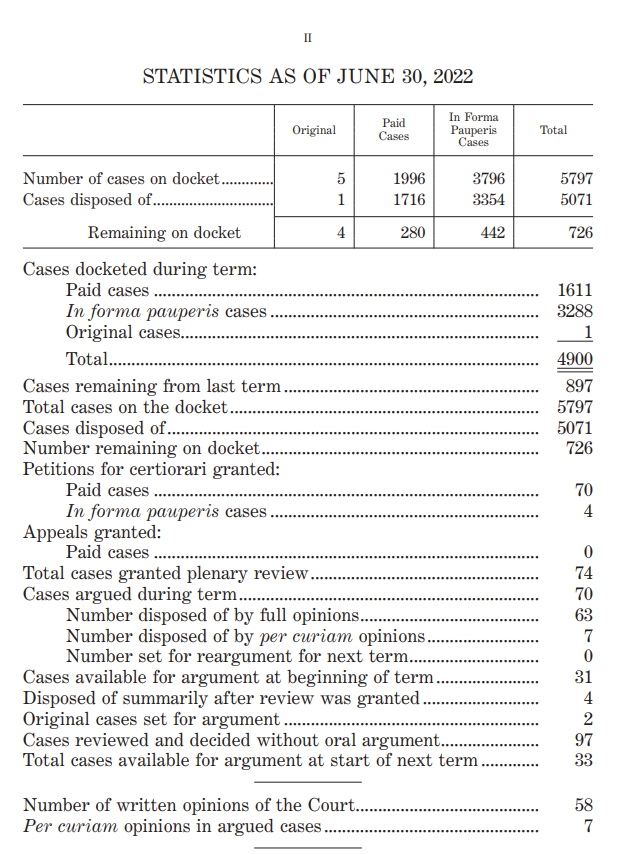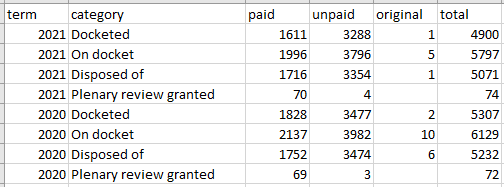SCOTUS Caseload Data
This repository contains data on the caseload of the Supreme Court of the United States. That is, it records how many cases are filed at the Court in every term, how many cases are on the Court’s docket in every term, how many cases they dispose of, and how many cases are granted plenary review. (In this context, “plenary review” contrasts with various summary dispositions.)
Where does the data come from?
These data were obtained from the Journal of the Supreme Court of the United States, which contains the official minutes of the Court. At the front of each term’s Journal, summary statistics on (among other things) the Court’s caseload are given; here’s an example from the Court’s most recent Journal:
I compiled statistics from each term’s journal into a single CSV file.
What’s in the dataset?
Currently statistics are available for the post-WWII Court (terms 1946–2021). For each term, I recorded information from the Journal about how many cases were docketed (i.e. filed at the Supreme Court), how many were on the Court’s docket (this includes the cases filed at the Court in the present term, plus any cases leftover from the previous term(s)), how many cases were “disposed of” (that is, the Court actually did something with it and got it off their docket), and how many cases were granted plenary review. The data look like this:
So each row of the dataset tells you, for a particular term, how many paid, unpaid, and original jurisdiction (and total) cases fall into a particular category. More specifically, the variables recorded are
term: This is an integer variable that records which “October Term” of the Court the data in the rest of the row correspond to. (The Supreme Court does not do business on or record statistics on standard calendar years that run from January to December; rather a term of the Court begins on the first Monday in October and runs until late June or early July, when the Court recesses until the next term begins.)category: This is a character variable that indicates what type of statistic is recorded in thepaid,unpaid,original, andtotalvariables. Possible values included- “Docketed”: This means how many cases were filed at the Supreme Court and put onto its docket.
- “On docket”: This means how many cases were on the Court’s docket, whether they were filed in this term or leftover from a previous term.
- “Disposed of”: This means how many cases the Court did something with and got off their docket. Most commonly this is done by declining to review a case. The Court also “disposes of” a case by issuing an opinion after full hearing, or by summary methods of disposition.
- “Plenary review granted”: This means how many cases the Court agrees to give a full hearing.
paid: This is an integer variable indicating how many paid appeals and petitions for writ of certiorari were recorded for the given term-category.unpaid: This is an integer variable indicating how many in forma pauperis appeals and petitions for writ of certiorari were recorded for the given term-category. That is, the Court allows indigent litigants to file cases for free. See Rule 39 of the Rules of the Supreme Court of the United States for details.original: This is an integer variable indicating how many original jurisdiction cases were recorded for the given term-category. That is, in some circumstances, litigants may file a lawsuit directly at the Supreme Court rather than filing in some other court first and ending up at the Supreme Court to appeal the ruling of that other court. See Rule 17 of the Rules of the Supreme Court of the United States for details.total: This is an integer variable indicating how many total cases were recorded for the given term-category. In general, this should be the sum ofpaid,unpaid, andoriginaland is mostly provided for convenience purposes. However, under some circumstances there can be differences. For example, the 1980 Journal of the Supreme Court lists 132 paid cases granted plenary review and 22 unpaid cases granted plenary review, but 158 total cases granted plenary review rather than 154 (see image below). Total discrepancies are in the Journal are rare, and are usually obvious typos (such as a transposed digits). In the case of transposed digits or one-off errors to a digit, I correct the “obvious typos”. In all other cases, I record the total given by the Journal even if it disagrees with the sum ofpaid,unpaid, andoriginal. (This only occurs 7 times in the data.)
Example of a total discrepancy in the 1980 Journal of the Supreme Court:


